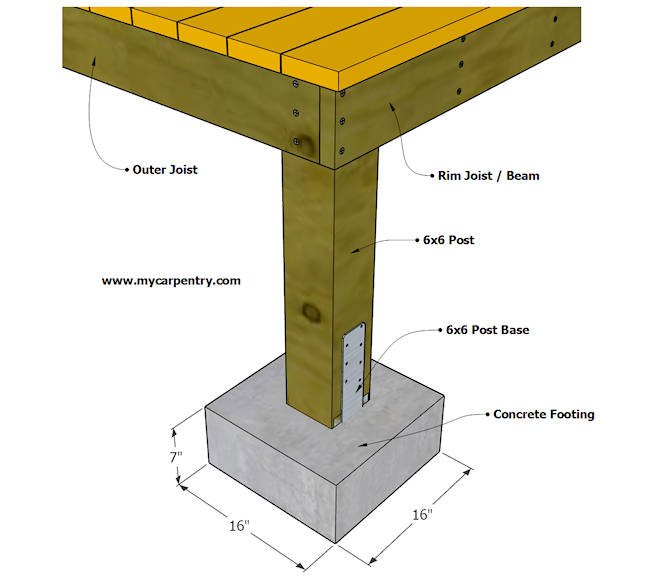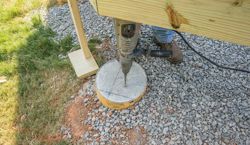Necessary Tips for Solid Deck Ground: A Comprehensive Overview
Building a deck is a financial investment that needs careful preparation and interest to information, especially when it comes to the ground. This overview will cover essential facets such as picking the ideal products, examining soil problems, determining load ability, establishing appropriate footing depth, and attaining specific installment. Let's dive into the world of solid deck ground and develop a structure you can depend on.
Choosing the Right Deck Footing Products
When picking the best deck footing products, it is vital to consider the specific demands and demands of your project. The high quality and durability of the footings directly impact the stability and longevity of the deck structure. There are numerous factors to consider when picking deck ground materials.
One crucial consideration is the kind of dirt in your area. Various soil kinds have differing load-bearing capabilities and water drainage residential or commercial properties. As an example, clay dirts often tend to preserve water, while sandy soils drain quickly. Comprehending your soil conditions will certainly aid you pick grounds that can effectively sustain the weight of the deck and prevent problems such as heaving or sinking.
One more variable to consider is the climate in your region. Extreme temperatures, wetness levels, and freeze-thaw cycles can impact the efficiency of deck grounds. In chilly environments, as an example, frost heave can trigger grounds to fracture or shift. In such cases, utilizing frost-resistant materials or mounting footings below the frost line can help reduce these threats.
Furthermore, the size and layout of your deck need to additionally affect your option of footing materials. Larger or even more intricate decks may require much deeper or strengthened grounds to guarantee ample assistance. Understanding the specific lots requirements of your deck will help you establish the proper materials to utilize.
Ultimately, choosing the appropriate deck footing products involves careful factor to consider of factors such as dirt problems, environment, and deck design. By taking these elements into account, you can select footings that offer the required assistance, boost the stability of your deck, and guarantee its durability.
Correctly Evaluating Soil Problems
To correctly assess dirt problems for your deck ground, it is essential to thoroughly evaluate the load-bearing capacities and drain homes of the dirt in your location. Recognizing the dirt's capacity to birth weight and its capability to drain excess water will certainly help guarantee the stability and durability of your deck.
When evaluating the load-bearing ability of the soil, it is essential to think about aspects such as dirt type, compaction, and density. Different soil kinds have differing load-bearing capabilities, with compacted dirts typically offering much better assistance than loose or sandy dirts. Conducting a dirt test can give useful information concerning the dirt's capability to support the weight of your deck.
In addition, evaluating the drain residential or commercial properties of the dirt is necessary to prevent water buildup and potential damage to your deck - Deck Footings. Poor drainage can result in moisture build-up, which can weaken the structure and trigger structural concerns. It is very important to evaluate the soil's ability to drain water successfully to stay clear of these issues
Consulting with a professional designer or dirt specialist can greatly aid in appropriately examining soil conditions for your deck ground. They can give expert suggestions and guidance, guaranteeing that you choose the ideal ground design and materials based upon the specific features of the soil in your area. Taking the time to completely examine soil conditions will assist you develop a resilient and solid deck.
Computing Lots Capacity for Grounds
One important action in making sure the security of your deck is to properly compute the load capability for your grounds. Deck Footings. The lots ability describes view it the optimum quantity of weight or lots that the grounds can securely sustain without creating any kind of architectural damage or failing. Determining the lots ability for grounds includes thinking about numerous elements such as the dimension and kind of footings, the type of dirt, the dimensions and weight of the deck, and the online tons and dead lots that the deck will certainly be subjected to
To calculate the load capacity, it is necessary to consult local building regulations and regulations as they supply particular standards and demands for deck building and construction. These codes take into consideration aspects such as dirt bearing capacity, frost deepness, and minimum ground dimensions. Additionally, it is vital to engage the services of an architectural designer or an expert contractor that can carry out the needed estimations and evaluations to ensure the safety and security and stability of the deck.
When computing the load capability, it is important to precisely establish the online load and dead load that the deck will certainly experience. The live lots describes the weight of individuals, furniture, and any type of various other things that will certainly be positioned on the deck, while the dead load describes the weight of the deck itself. By precisely determining these loads and taking into consideration all pertinent aspects, you can guarantee that your grounds are properly developed to support the weight and preserve the stability of your deck.
Guaranteeing Proper Ground Deepness
Correct ground deepness is critical for guaranteeing the stability and long life of your deck. The depth at which the footings are mounted directly influences the structural integrity of the deck, as it establishes exactly how well the grounds can withstand the pressures applied by the deck and the soil beneath it.
When identifying the proper ground depth, a number of variables must be thought about. In locations with expansive clay soil, much deeper grounds might be required to supply ample support.
To figure out the correct footing depth, it is suggested to speak with a structural engineer or structure assessor that can assess the certain conditions of your website and give guidance based on regional building ordinance and guidelines. They will certainly consider elements such as soil make-up, water table level, and expected loads to identify the minimum necessary footing depth.
Mounting Grounds With Precision
Mounting grounds with accuracy is important for guaranteeing the stability and structural stability of your deck. Appropriately installed footings give a strong structure, guaranteeing that your deck can endure the weight of furniture, individuals, and other loads. To mount footings with precision, there are numerous crucial steps to follow.
To start with, it is very important to click here to read precisely mark the area of each ground. This can be done by utilizing a string or chalk line to create a clear outline. By gauging and marking the exact placements, you can guarantee that the grounds are uniformly spaced and aligned.
Following, you need to dig the openings for the grounds. It is essential to dig them to the correct deepness and diameter, as defined by local building regulations and policies. This will certainly supply adequate assistance and avoid the deck from moving or sinking over time.
When the holes are dug, it is essential to level and small the dirt at the end of each opening. This will produce a stable base for the footing to rest on and avoid any kind of settling or movement.
After preparing the openings, you can proceed with pouring the concrete. Make use of a concrete mix that appropriates for grounds and adhere to the producer's guidelines for putting and mixing. Make sure that the concrete loads the holes totally and is degree with the ground surface.
Last but not least, allow the concrete to treat properly before continuing with the building and construction of your deck. This will make sure that the grounds are steady and solid, offering a safe structure for your deck.

Verdict
Finally, making certain solid deck footing is essential for the stability and longevity of a deck framework. By picking the suitable footing materials, analyzing dirt problems, determining recommended you read tons capacity, and installing grounds with accuracy, the danger of structural failing can be lessened. Complying with these important tips will certainly assist produce a solid foundation for any type of deck task.
Comprehending your dirt conditions will certainly assist you choose grounds that can successfully support the weight of the deck and protect against concerns such as sinking or heaving.
Consulting with a professional designer or soil specialist can considerably aid in properly analyzing soil conditions for your deck footing. Computing the load ability for footings entails thinking about various aspects such as the size and kind of footings, the type of soil, the measurements and weight of the deck, and the online lots and dead load that the deck will certainly be subjected to.
